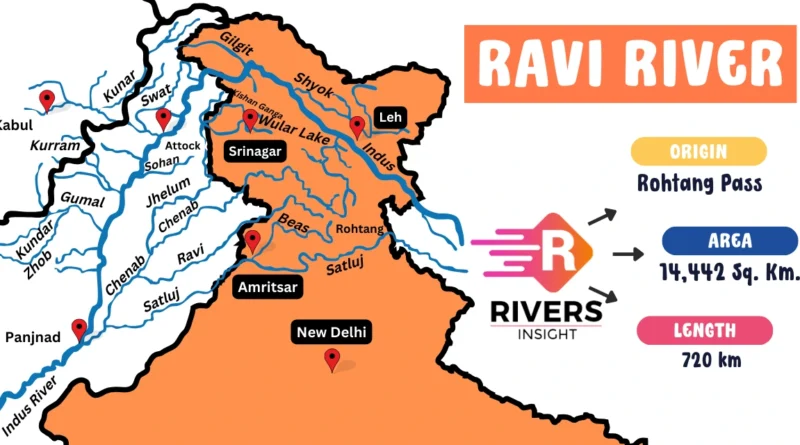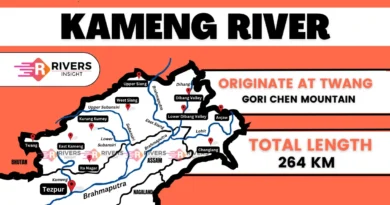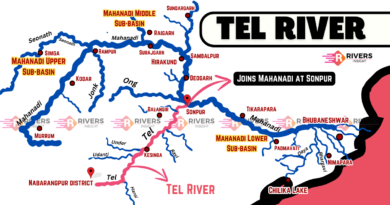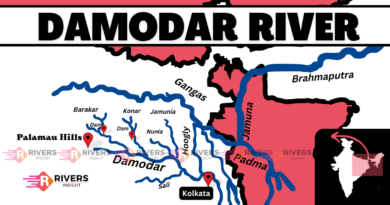Ravi River: Origin, Tributaries, and Dams with Map
The Ravi River is one of the five major rivers of the Punjab region, originating from the Lahul range in the Himalayas, flowing through India and Pakistan over a length of 720 kilometers.
In this article, we explore the origin of the Ravi River, its ancient name, its course, key tributaries, important dams, and provide a detailed map highlighting its flow across the region.
| River | Ravi |
| Length | 720 km |
| Origin | Lahul range |
| Old Name | Purushni |
| Countries | India & Pakistan |
| Area | 14442 sq. km |
Table of Contents
Where Does the Ravi River Originate?
The Ravi River originates in the Lahul Range of the Himalayas in Himachal Pradesh, India. The river starts its journey from the Pangi Valley, located in the eastern part of the Himachal Pradesh state. From there, it flows southwards through India, crossing through Punjab before crossing into Pakistan, where it finally merges with the Chenab River, a major tributary of the Indus River.
Course
Ravi River starts in the Lahul Range in India and flows towards the southwest, passing through various towns and cities in the Indian states of Himachal Pradesh and Punjab. Once it enters Pakistan, it merges with the Chenab River.
Some key locations along the river include:
- Chamba (Himachal Pradesh)
- Dera Baba Nanak (Punjab, India)
- Lahore (Pakistan)
- Kasur (Pakistan)
Ravi River Flows Through Which States?
- In India: Himachal Pradesh & Punjab
- In Pakistan: Punjab province
Map of the Ravi River

Tributaries
The major tributaries of the Ravi River include:
- Budhil River: Originates in the Lahul Range of the Himalayas.
- Nai (Dhona) River: Flows from the Kali Debi Pass.
- Seul River: Joins the Ravi below Bharmour, an ancient capital of Chamba.
- Seva River: Flows into the Ravi near Basohli, Jammu and Kashmir.
- Tant Gari River: A small tributary from the Pir Panjal Range.
List of Major Dams on the Ravi River
- Thein Dam (Ranjit Sagar Dam) – Chamba, Himachal Pradesh
- Chamera Dam – Chamba, Himachal Pradesh
- Shahpurkandi Dam – Pathankot, Punjab
- Ujh Dam – Kathua, Jammu & Kashmir
- Ravi-Beas Link (Proposed)
- Upper Bari Doab Canal – Irrigation canal system in Punjab
FAQs
Where does the Ravi River start and end?
The Ravi River starts in the Lahul Range of the Himalayas in India and flows through Punjab in both India and Pakistan, eventually merging with the Chenab River.
What is the old name of the Ravi River?
The Ravi River is historically known as Iravati in ancient texts, particularly those related to the Indus Valley Civilization.
Which states does the Ravi River flow through?
The Ravi River flows through Himachal Pradesh and Punjab in India, and later enters Pakistan, where it merges with the Chenab River.
What is the length of the Ravi River?
The Ravi River spans approximately 720 kilometers, making it one of the major rivers of the Punjab region.
Do you have more questions about the Ravi River or other rivers of India and Pakistan? Drop your queries in the comments section below, and we’ll be happy to answer them! Don’t forget to share this article with your.




